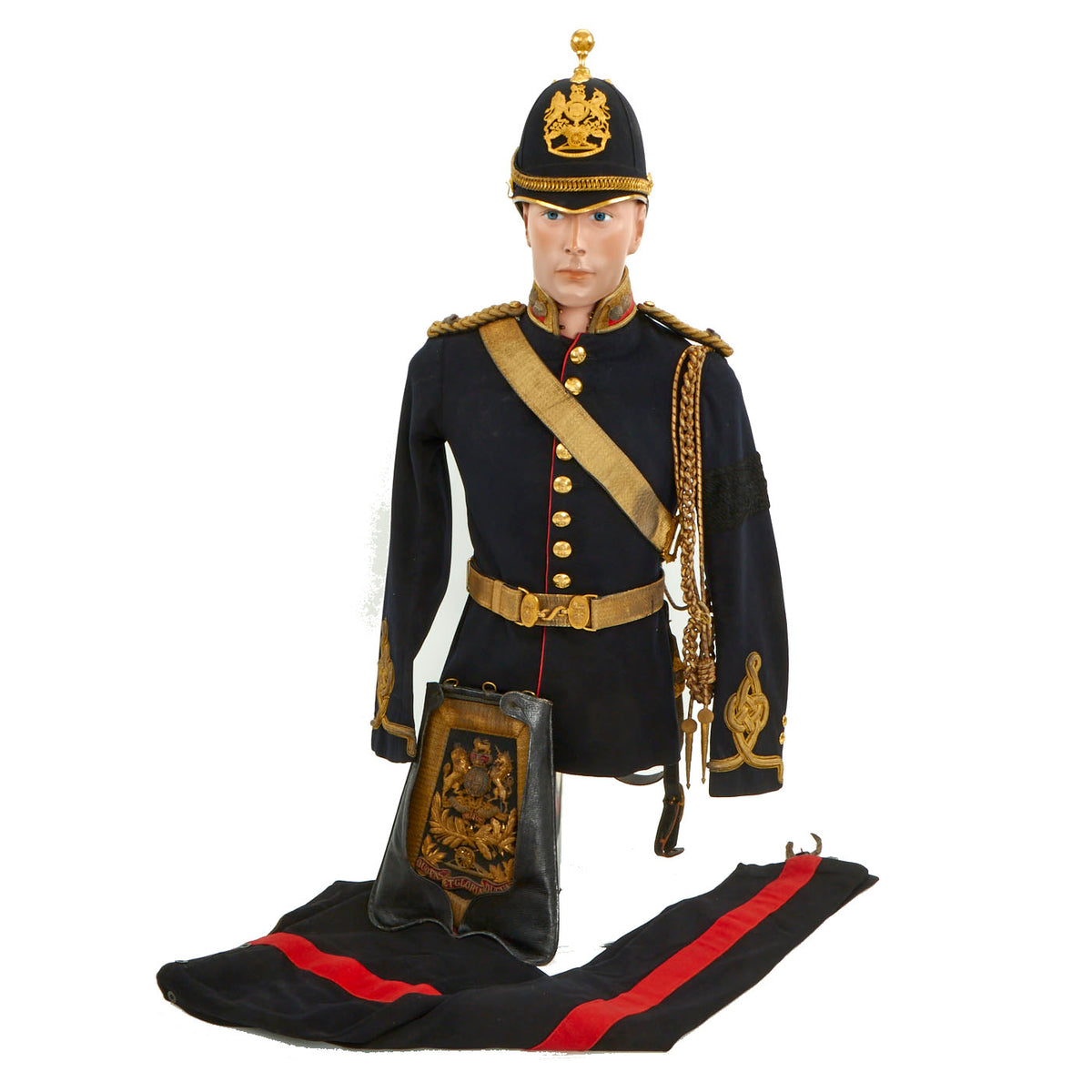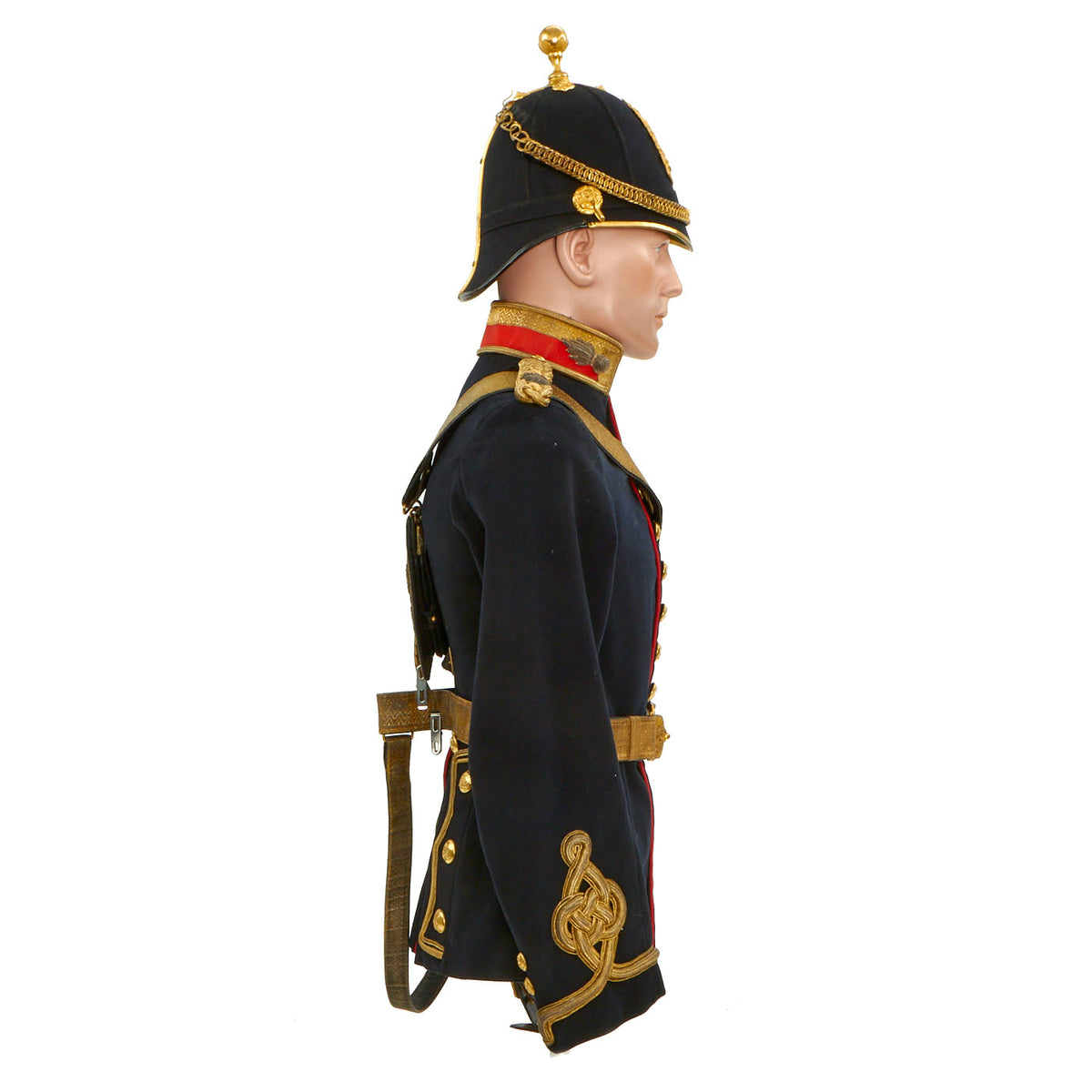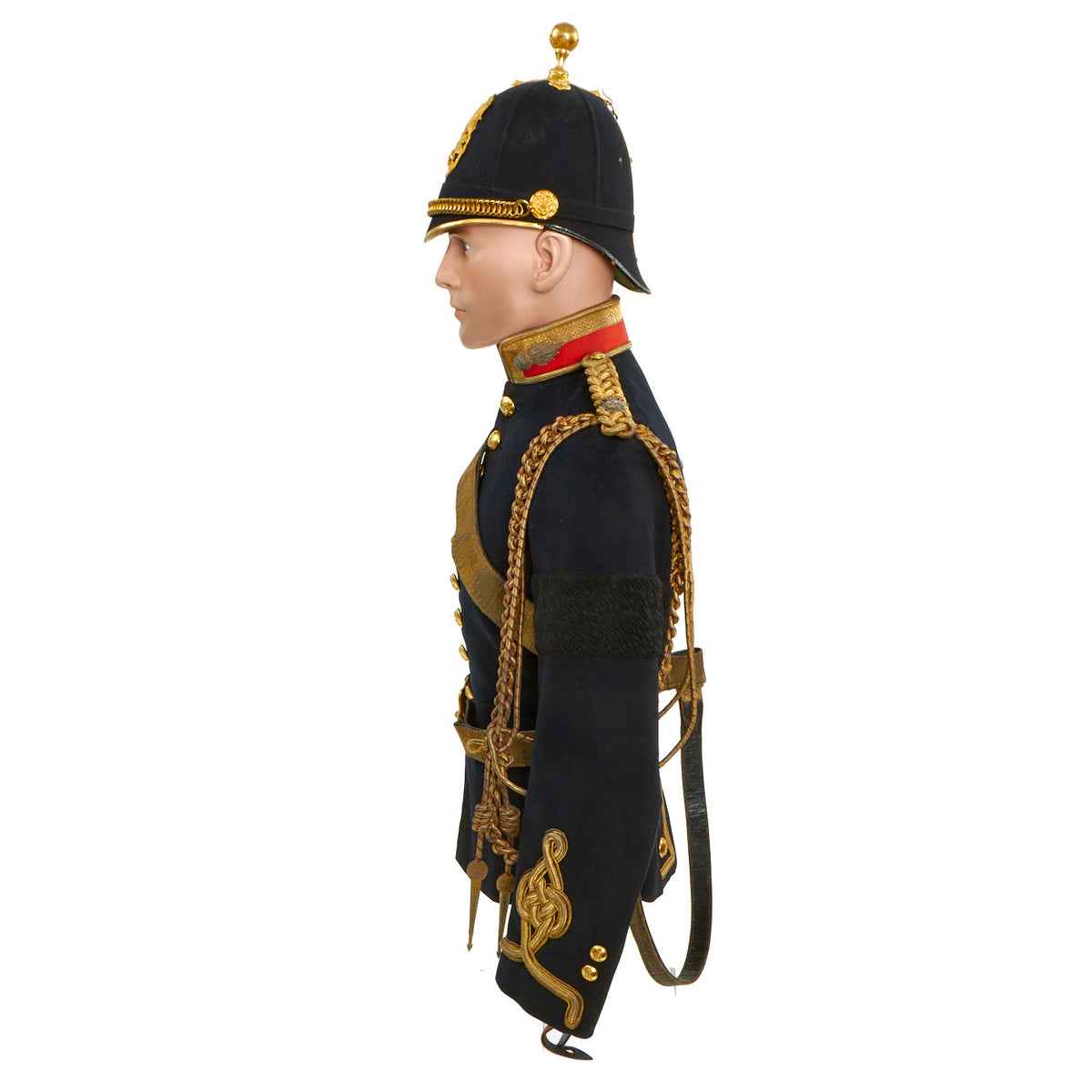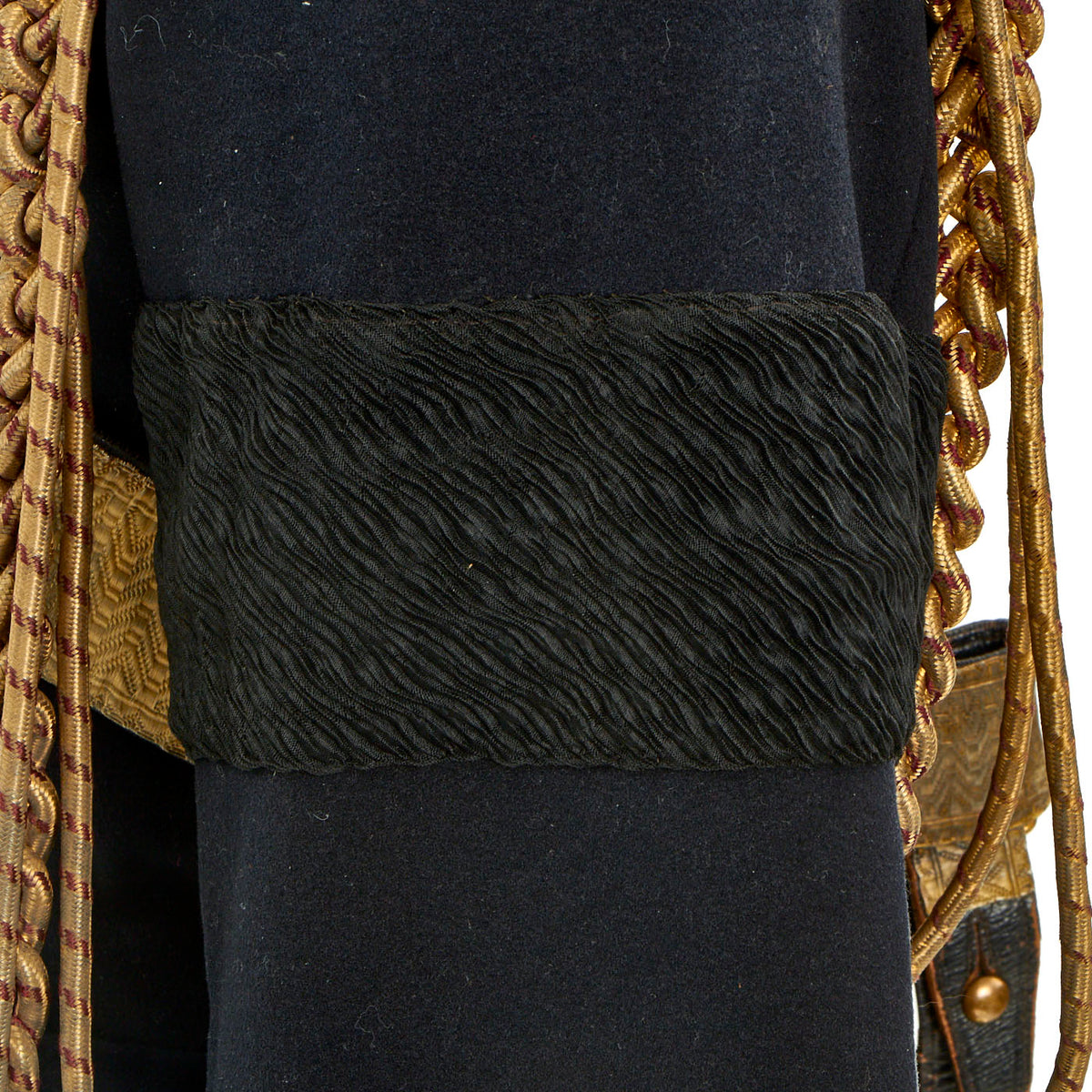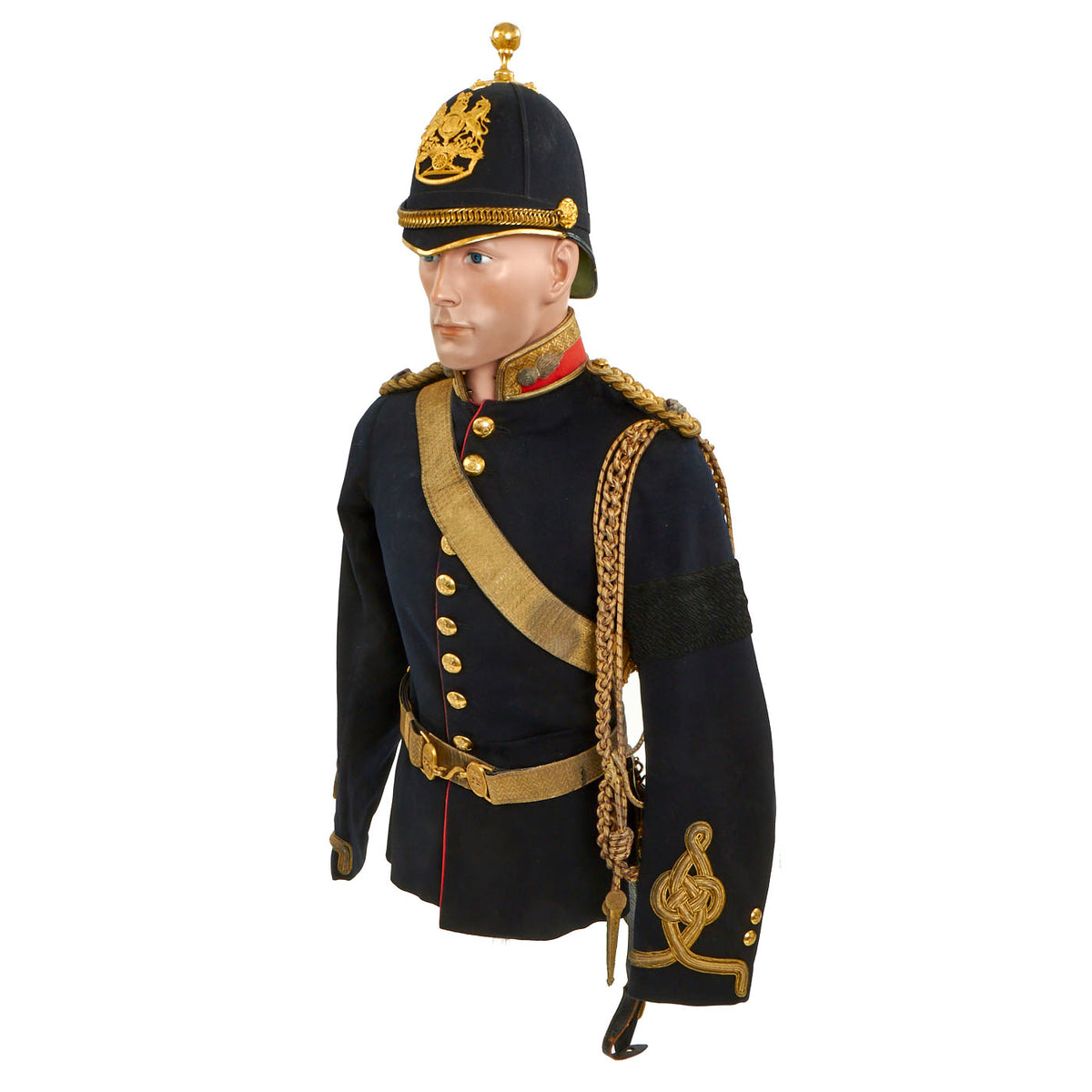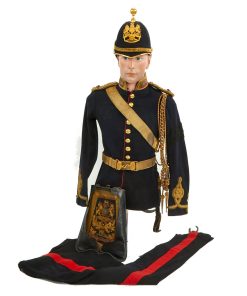Original British WWI Royal Field Artillery Major’s Named Uniform Set – Sir Henry Pownall KCB, KBE, DSO & Bar, MC Original Items
$ 3.595,00 $ 898,75
Original Items: One-Of-A-Kind. Now this was an incredible discovery! On top of it being an already stunning uniform set, we discovered who it belonged to, thanks to the name written on the tailor’s tag. Lieutenant General Sir Henry Royds Pownall, KCB, KBE, DSO & Bar, MC was a senior British Army officer who held several important command and staff appointments during the Second World War. In particular, he was chief of staff to the British Expeditionary Force (BEF) in France and Belgium until the fall of France in May 1940. He was later chief of staff to General Archibald Wavell until the Battle of Singapore in 1942, and chief of staff to Lord Louis Mountbatten in 1943–44.
Pownall was born on 19 November 1887 and received his education at Rugby School and Royal Military Academy, Woolwich. After graduating he began his military service with the Royal Field Artillery and Royal Horse Artillery, during which he was stationed in both Britain and India 1906–1914. In 1909 he was promoted to lieutenant, and then captain in 1914.
During the First World War, Pownall served in both France and Belgium. He was promoted to Major in 1917 and oversaw the Royal Artillery, 17th Division. For his service during the war Pownall was awarded the Distinguished Service Order in 1918. This dress uniform would have been one he wore towards the end of WWI and afterwards.
This Grouping Consists of the Following:
– The Royal Artillery Pattern 1878 Helmet: The foot artillery wore the same headdress as the infantry from the beginning of its existence. In 1856 they adopted the busby, which had been authorised the previous year. This headdress was similar to that of the RHA but with significant differences. There were no caplines and the goatshair plume was placed on the left side stemming from a brass grenade socket. The top of the plume reached the top of the busby. The red bag was on the right side. In 1878, the individuality ended as they were ordered to wear the infantry pattern helmet, modelled somewhat on the Prussian model. (The victory over France by the Germans in 1870 had spawned imitation of this helmet by many countries).
The Officers’ helmet was made of cork covered in dark blue cloth in four seams. The peak, front and back stiffened and covered with unseamed blue cloth. The front peak was bound with gilding metal 3/16th ins wide and the back peak with patent leather. The distance from both peaks to the centre of the crown was 10 ½ Ins and 8 ins from side to top. There was a gilt convex bar down the rear of the helmet. The gilt curb chain was attached to two gilt rosettes on the side. A gilt cross piece at the top of the helmet had a gilt 2 ¾ spike screwed into the top.
By 1881, it was decided that a ball finial should replace the spike (ostensibly to protect horses from injury). Again a feature of the German artillery. Because of campaign activity, many officers did not replace the spike until the end of 1882.
– Belt & Sabretache: In 1833 RHA had worn a blue Morocco leather belt covered in gold lace with an S hook fastening with gilt lion’s heads either side. From 1855 the entire regiment adopted a similar belt with gilt loops for the sword & sabretache slings. The fastening was two gilt plates with the Royal Crest joined by a snake hook inscribed “UBIQUE”. Before 1900, a web belt with sword slings was worn by all officers below the RHA jacket and the RA tunic and the belt was used as a girdle. This belt has a Canadian buckle and hook but a proper British buckle is included with this purchase. The Sabretache was carried by all RHA officers and RA mounted officers from 1833. The design was identical to that on the shoulder belt pouch with a different arrangement of the Royal Arms, sprays and scrolls. The gun was redesigned in 1872. The sabretache was abolished in 1902. Both the belt and sabretache are in lovely condition with minor detachment of the gold cloth on the belt.
– Named Tunic with Trousers: Along with much of the rest of the army, the Royal Artillery (Field and Foot Units) adopted a tunic to replace the coatee in 1856. It evolved through the years becoming more form fitting and with shorter skirts. The collar and cuff decorations were similar to those of Hussars. The tunic had rounded skirts in front and was edged all round with scarlet cloth. There was a single vent piped scarlet with two buttons at the hip. In 1874 the hip buttons were described as being on the seams and the rear skirts were piped on each seam. There were gold shoulder cords and the rank badges were on the scarlet collar. In 1881 the rank badges were moved to the shoulders which now had gold plaited cords and a silver bullion grenade was adopted for the collar which was rounded in front and 1 ½ inches high . There was a major change in 1891 when the front skirts were squared off and the piping was only down the front. On the rear skirts were two blue cloth three pointed flaps, each edged with gold cord lace and buttons at the point of each flap and two at the hip. The collar on the tunic was now squared and now two inches high.
The rear top of the tunic still displays the manufacturer label as well as Sir Pownall’s name:
J. Daniels & Co
1 Artillery Place Woolwich
& 34 Bury St St. James.’ S.W
H.R. Pownall Esq RA
The Royal Artillery button was, before 1874, a crown over three cannons. After that date the button was a crown over one cannon. There were two sizes: Large at 35-40 lines and Small, 24 to 29 lines.
In 1855 the shoulder belt was adopted by officers of the whole regiment. It was in two pieces of blue Morocco leather covered in gold lace 2 Inches wide. The short piece had an ornamental gilt buckle and slide and the long had a tip of a gilt grenade encircled by a wreath. In 1855 the Pouch was described thus: The Royal Arms and Gun badge in gold embroidery on blue Morocco leather faced with dark blue cloth. A laurel spray on the dexter (right) and an oak spray on the sinister (left) side. The Gun in gilding metal Regimental lace 3/4″ wide round the edge. Below a crimson scroll with the motto “QUO FAS ET GLORIA DUCUNT” in gilt embroidered lettering. The gun was redesigned in 1872.
It was worn by all RA & RHA officers. The size varied throughout the years.
The “netherwear” of the Royal Artillery was the same as that for all of the army. For dress and levees, trousers and overalls had 1 ¾ inch regimental lace down each side. Pantaloons no longer had gold lace down the sides but instead had 1 ¾ inch scarlet stripes. Overalls were worn by the Royal Horse Artillery while trousers were worn by the Foot Artillery.
This is an incredible uniform set that would be welcomed into any caliber of Royal Artillery collection. Comes ready for further research and display!
Following the war, Pownall attended the Staff College, Camberley from 1920 to 1921, and then served as a brigade major at the School of Artillery in Larkhill from 1924 to 1925. He continued his training and education as General Staff Officer (Grade 2) at the Staff College, Camberley from 1926 to 1929 where he became a brevet lieutenant colonel in 1928. After completing his training at Staff College he took part in Great Game operations in the North West Frontier of India through 1931.
He attended the Imperial Defense College in 1932, and, following this, he held a series of staff appointments, serving as the Military Assistant Secretary for the Committee of Imperial Defense from 1933 to 1935, then as Deputy Secretary for the Committee of Imperial Defense in 1936. From 1936 to 1938, he was Commandant of the Royal School of Artillery. As the threat of war grew, he was Director of Military Operations and Intelligence in the War Office from 1938 to 1939.
Britain entered the war after Germany invaded Poland on 1 September 1939. Pownall held a series of command and senior staff positions throughout the war. He was appointed Chief of General Staff for the British Expeditionary Force (BEF) in France and Belgium until the fall of France in May 1940. He then assumed the position of inspector general for the recently created Home Guard and was Commander of British Troops in Northern Ireland, before being appointed the Vice Chief of the Imperial General Staff in the War Office in 1941.
He subsequently became commander-in-chief of the British Far East Command in SouthEast Asia until 1942, when it was succeeded by the short-lived ABDACOM where he became chief of staff to General Sir Archibald Wavell. Afterwards he assumed the role of Commander-in-Chief, Ceylon from 1942 to 1943, and commander-in-chief of the Persia and Iraq theaters in 1943. Finally, he was appointed chief of staff to Vice Admiral Louis Mountbatten, the Supreme Commander of the Allied South East Asia Command from 1943 to 1944. After the conclusion of the war he retired from the British army in 1945.
During the war Pownall received the distinctions of Knight Commander of the Order of the British Empire in 1940 and Knight Commander of the Order of the Bath in 1945.
Awards
Knight Commander of the Order of the Bath
Knight Commander of the Order of the British Empire
Distinguished Service Order & Bar
Military Cross
Mentioned in Despatches (4)
Order of Orange-Nassau (Netherlands)
Measurements:
Collar to shoulder: 9”
Shoulder to sleeve: 24”
Shoulder to shoulder: 15”
Chest width: 17”
Waist width: 14.5”
Hip width: 19”
Front length: 29″
Pants: 30″
Inseam: 34″
NOTE: Mannequin Not Included.
Fast Shipping with Professional Packaging
Thanks to our longstanding association with UPS FedEx DHL, and other major international carriers, we are able to provide a range of shipping options. Our warehouse staff is expertly trained and will wrap your products according to our exact and precise specifications. Prior to shipping, your goods will be thoroughly examined and securely secured. We ship to thousands clients each day across multiple countries. This shows how we're dedicated to be the largest retailer on the internet. Warehouses and distribution centres can be located throughout Europe as well as the USA.
Note: Orders with more than one item will be assigned a processing date depending on the item.
Before shipping before shipping, we'll conduct a thorough inspection of the items you have ordered. Today, the majority of orders will be delivered within 48 hours. The delivery time will be between 3-7 days.
Returns
The stock is dynamic and we cannot completely manage it because multiple stakeholders are involved, including our factory and warehouse. So the actual stock may alter at any time. It's possible that you may not receive your order once the order has been made.
Our policy is valid for a period of 30 days. If you don't receive the product within 30 days, we are not able to issue a refund or an exchange.
You can only return an item if it is unused and in the same state as the day you received it. You must have the item in its original packaging.
Related products
Uncategorized
Uncategorized
Uncategorized
Uncategorized
Armored Burgonet Helmet & Polearm from Scottish Castle Leith Hall Circa 1700 Original Items
Uncategorized
Uncategorized
Band of Brothers ORIGINAL GERMAN WWII Le. F.H. 18 10.5cm ARTILLERY PIECE Original Items
Uncategorized
Uncategorized
Uncategorized
Uncategorized
Angolan Rebel 1970s era 60mm Inert Display Mortar from Angolan Civil War Original Items
Uncategorized
Australian WWII Owen MK1 Machine Carbine SMG Custom Fabricated Replica with Sling Original Items
Uncategorized
Uncategorized
Uncategorized
Uncategorized
Uncategorized
Uncategorized
